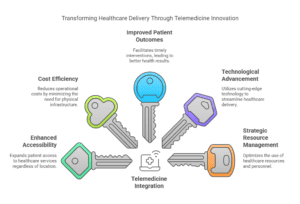On-Demand Outsourcing BPO Services for Healthcare Providers With 24/7 Coverage!
Save up to 70% on staffing costs!
Browse Specialty Staffing ServicesHow Telemedicine Benefits Hospital Management Teams with Remote Patient Care?

As the healthcare landscape continues to evolve, telemedicine has become a crucial tool for hospital management teams to provide effective care while ensuring operational efficiency. Remote patient care through telehealth not only benefits patients but also enhances hospital operations. From improving accessibility and patient satisfaction to optimizing hospital resources, telemedicine is changing the way hospital management teams deliver services.
Let’s explore how telemedicine benefits hospital management teams in managing remote patient care.
Why Hospital Management Teams Need Telemedicine for Remote Patient Care

Managing hospital operations involves coordinating numerous departments and ensuring high-quality care for patients. In a busy healthcare environment, several challenges exist that can hinder the delivery of effective care. These challenges include:
- Overcrowded Hospitals: Many hospitals face overcrowding, especially in emergency departments, leading to longer wait times and less personalized care.
- Limited Access to Care: Patients in rural or underserved areas often struggle to access healthcare services due to geographic limitations, transportation issues, or lack of nearby specialists.
- Cost Pressures: Hospital management teams must navigate rising healthcare costs while improving patient care, creating pressure to maximize resources efficiently.
- Staff Shortages: A lack of adequate healthcare providers, including specialists, makes it difficult for hospitals to meet patient demands.
- Patient Satisfaction and Retention: Ensuring patients are satisfied with their care and encouraging retention has become increasingly important in today’s healthcare market.
Telemedicine offers a practical solution to these issues, providing hospital management teams with the tools they need to offer remote patient care effectively and efficiently.
How Telemedicine Benefits Hospital Management Teams
1. Reduces Overcrowding in Hospitals
Overcrowding in hospitals is a significant concern for hospital management teams. With telemedicine, many non-emergency cases can be addressed remotely, reducing the burden on emergency rooms and urgent care departments. Key benefits include:
- Virtual triage: Telemedicine allows hospital teams to conduct initial assessments remotely and prioritize cases that require in-person care.
- Reduced emergency room congestion: Routine check-ups, follow-up visits, and minor concerns can be managed via telehealth, leaving space for more critical cases in the hospital.
- Faster patient throughput: With fewer in-person visits required, hospitals can reduce patient wait times and improve overall flow.
2. Increases Access to Care for Remote Patients
Telemedicine enables hospitals to extend their reach beyond their physical locations, improving healthcare access for remote or underserved patients. Benefits include:
- Reach to rural areas: Patients who live in remote areas can now access healthcare services without having to travel long distances.
- Access to specialists: Telemedicine bridges the gap for patients who need specialist consultations but lack the necessary specialists in their area.
- Follow-up care: Patients recovering from surgery or ongoing treatments can receive follow-up consultations remotely, reducing the need for frequent hospital visits.
3. Optimizes Resource Utilization
By offering remote care, hospital management teams can optimize their resources and ensure the most effective use of healthcare professionals and facilities. Key advantages include:
- Maximized staff efficiency: With telemedicine, providers can handle consultations remotely, reducing the need for in-person visits and allowing them to manage their time more efficiently.
- Improved workflow: Telemedicine can streamline appointment scheduling and allow staff to focus on more critical tasks that require in-person attention.
- Cost savings: Telemedicine reduces operational costs by eliminating the need for additional in-office resources such as space, office staff, and equipment.
4. Addresses Staff Shortages
Telemedicine helps hospitals combat staff shortages by allowing healthcare providers to treat more patients remotely without compromising the quality of care. Benefits include:
- Remote consultations with specialists: Telemedicine allows specialists to connect with patients in hospitals or clinics without being physically present, increasing the availability of specialists in underserved areas.
- Expanding provider reach: Hospitals can now expand their network by collaborating with telemedicine providers, enabling them to provide care for more patients with fewer staff members.
- Reduced burnout: By integrating telehealth into workflows, hospital staff can avoid burnout by offering more flexible working hours and reducing the number of in-person consultations.
5. Enhances Patient Satisfaction and Retention
Patient satisfaction is a key component of hospital success. With telemedicine, hospital management teams can improve patient experience by offering more convenient and accessible care options. Key benefits include:
- Convenience: Patients can access care from the comfort of their homes, eliminating the need to travel or take time off work.
- Faster consultations: Telemedicine offers quicker access to healthcare providers, reducing wait times and improving patient satisfaction.
- Personalized care: Telehealth allows hospital teams to maintain regular communication with patients, offering continuous support during treatment or recovery.
6. Supports Hospital Continuity of Care
Telemedicine ensures that patients continue to receive care even if they are unable to visit the hospital in person. Benefits include:
- Chronic disease management: Patients with chronic conditions can receive continuous monitoring and consultation remotely, improving long-term health outcomes.
- Post-surgery follow-up: Hospital teams can conduct follow-up consultations for patients after surgery, reducing the need for physical visits and ensuring they recover well.
- Remote monitoring: Wearable devices and telemedicine apps can allow patients to track their health status, with the data being shared directly with their healthcare provider for review.
Why Hospital Management Teams Should Integrate Telemedicine
Hospital management teams should consider adopting telemedicine to achieve:
- Better patient outcomes through increased accessibility and regular follow-up care.
- More efficient use of hospital resources, reducing the strain on in-person visits and allowing healthcare staff to handle more patients.
- Lower operational costs, including travel and facility-related expenses.
- Increased patient satisfaction and retention by providing easy access to healthcare services.
- Improved healthcare access, especially for underserved and rural populations.
By integrating telemedicine into their care model, hospital management teams can enhance their service offerings, streamline operations, and improve overall patient care.
Conclusion
Telemedicine provides immense benefits to hospital management teams, offering a solution to overcrowding, improving patient access, optimizing resources, addressing staff shortages, and enhancing patient satisfaction. As telehealth continues to grow, hospitals that embrace remote patient care will be better equipped to meet the needs of their communities while maintaining operational efficiency.
What People Are Asking
1. How can telemedicine help with hospital overcrowding?
Telemedicine reduces the number of in-person visits by providing remote consultations, freeing up space in emergency rooms and improving patient flow.
2. What are the benefits of telemedicine for remote patients?
Telemedicine improves access to healthcare for patients who live in rural or underserved areas, allowing them to consult with specialists and receive care from home.
3. How does telemedicine optimize hospital resources?
By reducing the need for in-person visits, telemedicine helps hospitals optimize staff time, reduce overhead costs, and streamline workflows.
4. Can telemedicine address staff shortages in hospitals?
Yes, telemedicine allows hospitals to expand access to specialists remotely, ensuring that patients can receive care even when providers are not physically available.
5. How does telemedicine improve patient satisfaction?
Telemedicine increases patient satisfaction by offering more convenient, timely, and accessible care, reducing wait times and travel costs.
Disclaimer
For informational purposes only; not applicable to specific situations.
For tailored support and professional services,
please contact Staffingly, Inc. at (800) 489-5877
Email: support@staffingly.com.
About This Blog: This Blog is brought to you by Staffingly, Inc., a trusted name in healthcare outsourcing. The team of skilled healthcare specialists and content creators is dedicated to improving the quality and efficiency of healthcare services. The team passionate about sharing knowledge through insightful articles, blogs, and other educational resources.
 Book a Demo to Build Your Team Today!
Book a Demo to Build Your Team Today!
 Read Case Studies
Read Case Studies 



 Virtual Medical Assistants
Virtual Medical Assistants



